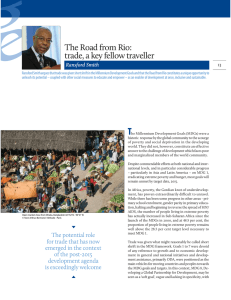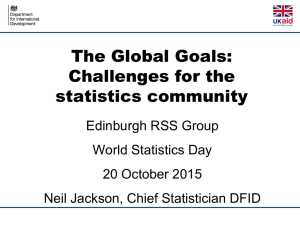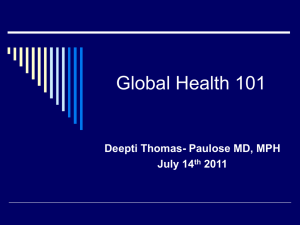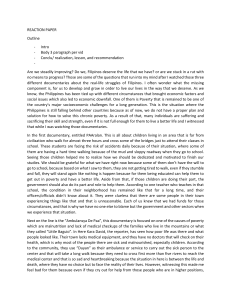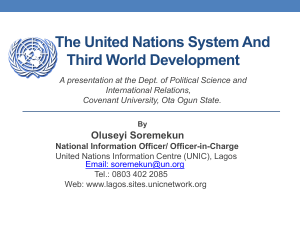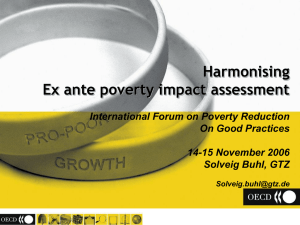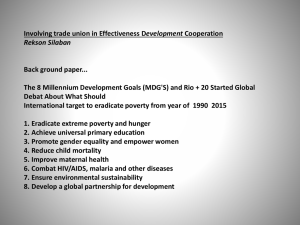Human resource development, productivity and employment
advertisement
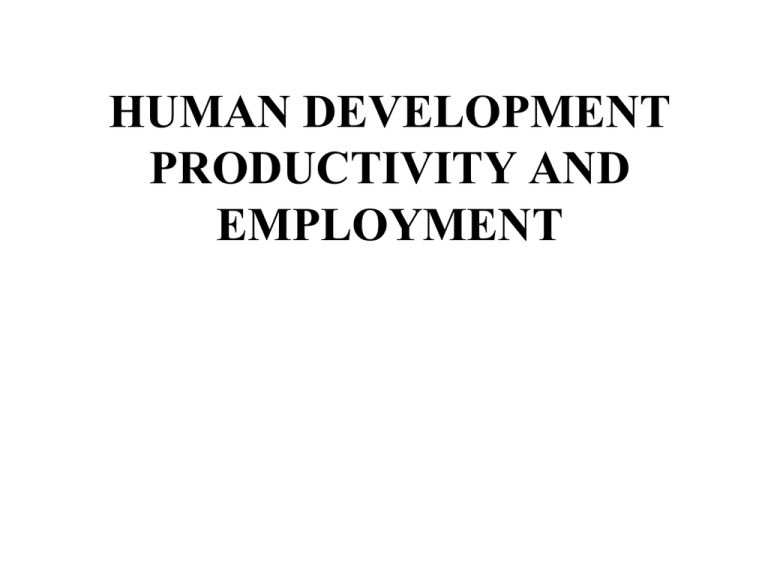
HUMAN DEVELOPMENT PRODUCTIVITY AND EMPLOYMENT OUTLINE Introduction 1. Summary of issues 2. What is working 3. Looking ahead: Focus on outcomes 4. What makes progress achievable 5. Creating circumstances for change INTRODUCTION INTRODUCTION • Well educated, skilled and healthy population essential for any strategy of national development • In Ghana this should occur within a decentralised system of planning and implementation • Specifically in the area of human resources, critical issues revolve around their development, deployment and management • Thematic area includes: education, human resource development, productivity & employment, health promotion including HIV, AIDS and STDS, population management including migration, youth and sports development , poverty reduction and social protection SUMMARY OFISSUES ISSUES - I SUMMARY OF • Education: Uneven access and gender disparity at all levels; Poor quality of teaching and learning; Governance and management constraints • Human resource development, productivity and employment: inadequate employment opportunities, low productivity, inadequate labour market information system, occupational health and safety issues • Health:child and maternal survival, sustainable financing arrangements, maldistribution of health sector workers; Stigma and discrimination associated with HIV and AIDS SUMMARY OF ISSUES - II • Population management: reprioritising family planning, inadequate database for planning, and optimising impact of migration • Youth and Sports development: weak institutional framework, under-mobilisaion and utilisation of youth talent; sports policy, infrastructure and management • Poverty reduction: spatial, gender and income inequalities • Social policy: framework, equity, social protection, the care economy and common targeting mechanism GEOGRAPHICAL DISPARITIES Primary completion rates Attendance Rate in Current School Year POVERTY MATTERS! Figure 5.1. Attendance Rates Aged 6-14 by Poverty Quintile, 2003-2008 100 80 60 40 2003 20 2008 Source: GDHS 2003, 2008 GENDER INEQUALITY HUMAN RESOURCE ISSUES Cf. Ratios of trained health personnel/population WHAT IS WORKING - I Education: Ghana is on track to meet MDG 2. (See map) Health: steady progress on MDG 4 on child survival and MDG 6 on HIV and AIDS, Malaria and TB; NHIS Human resource development, Employment and Productivity: draft policies in HR and Employment, NYEP; establishment of Fair Wages and Salaries, Labour Commissions; Social Dialogue mechanism WHAT IS WORKING - II Population management: Integration of population variables in development planning processes; declining fertility rate •Poverty reduction: Ghana has met MDG 1 on halving poverty • Social policy: draft Social Protection Strategy, LEAP, Capitation grant, school feeding Looking ahead ….. Focus on outcomes in education Equity in access Gender equality •Complementary basic education •Girls scholarships and work with the Girls’ Education Unit •Construction of classrooms, water and sanitation facilities •Mix of incentives for teachers in rural areas •Common targeting mechanism •Counselling and guidance at school level •Child and girl friendly school standards Quality •Implement teacher professional development policy •Improve the deployment and % trained teachers •Provision of textbooks and alternative learning materials •School report cards to increase accountability Productivity and employment Human resource • Labour market information system • National HR development plan • Smart Use of incentives Productivity Employment • Establish mechanisms to enhance job security • Adopt national employment policy • National productivity measurement framework • Adopt national income policy • Address occupational health and safety • Promote decent work in the informal economy Outcomes in social policy Establish framework and strengthen systems •Expansion of adequate social security and disability provision • Mainstream and finance child rights issues •Updating the national social protection strategy •Progress the common targeting mechanism aimed at linking poverty reduction programmes Evidence based •Strengthening the evidence base by emphasising M&E functions and products •Strengthening national ownership of the national social policy by: i) high level cross- Ministerial parliamentary forums ii) Regional, district and community level engagement iii) Building GoG/civil society /DPs dialogue Focus on outcomes in health Priorities Joint Strategies and Actions •Improved access to quality health services for all Ghanaians •Strengthening health systems •Measurable progress in reducing child and maternal mortality •Improving the national-level health sector partnership •Joint action plan on maternal and child health •Continued involvement by non-resident partners e.g. The Global Fund and GAVI •Implementing the Sector Medium Term Development Plan •Improving intra-sectoral collaboration Creating the circumstances for change How do we reform? intervention Policy level intervention Institutional level intervention Human level • Wage bill • Unit costs • Human resources • Address Migration • Targeting • Inclusive strategies Improved situation (results) What makes progress achievable? • Significant financial investment from the government 31% education, 17% health • Retention of adequate skilled staff motivated to adopt professional development policies for careers • Strengthened role for Parliament, MMDAs and CSOs to ensure greater accountability • Improvements in data collection and monitoring • Enhance the quality of dialogue between DPs and the Government through sector working groups •Incorporating evidence in policy and programming
